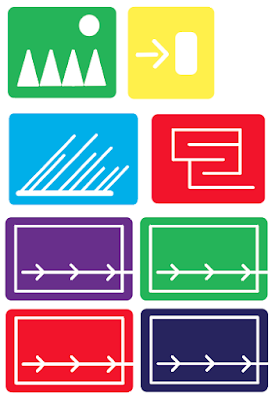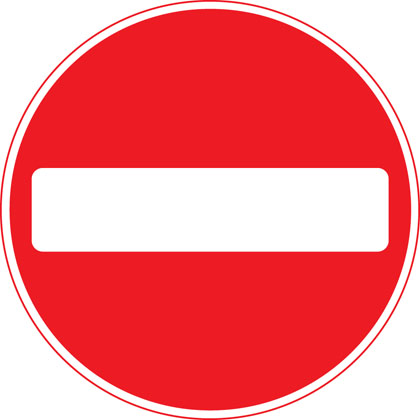Escape
 |
| Fig.1 |
 |
| Fig.2 |
 |
| Fig.3 |
To visually communicate the word 'Escape', I have attempted to take the essence of the feeling of escape, and translate it into objective symbols. Fig.1 and Fig.2 are more conceptual and abstract representations of the word, created using the letters 'E', 'S' and 'C' of the alphabet. Fig.3 is inspired by Lance Wyman.
Fig.1 symbols look quite pleasing aesthetically, they are detailed and intriguing. However, to be appropriate objective symbols they lack simplicity. Also, the confinements of the square they are placed in, which according to Fruitinger represent "boundaries...[and] the feeling of floors, ceiling, walls" does not communicate the word 'escape'. To make the symbols more successful I would have to break free the elements within the symbols, and let them flow over the lines.
Fig.2 are collages using letterforms. They represent 'escape' more successfully as the elements within them extend beyond their square boundaries. They have a much more objective feel, as they are not too complicated and have potential to be easily recognisable. The choice of colour was not initially considered, so the designs are weakened because of that. However, if I were to improve them now I would re-design them on tones of green, as green is associated with 'Exit' signs, freedom and nature, all being associations of 'escape'.
Fig.3 are designs influenced by Lance Wyman and his use negative space and colour, especially distinctive in his Mexico 68 Olympics pictogram designs. I thought this his style would be appropriate because it gives the idea of 'escape' a more positive feel. Whereas the other designs presented 'escape' as aggressive and forceful, these ones I believe show the more peaceful and organised side of it. The signs look objective because of their simplicity and frame. The square frame gives a feeling of certainty, with the rounded corners adding gentleness. The use of white negative space and soft rounded lines for the imagery inside gives the designs purity. These things successfully communicate the freedom and nature side of 'escape'. The choice of colour is not appropriate in all the designs. Whilst the soft green, bright yellow, and sky blue all are gentle and work well, the purple, red and navy seem harsher and too serious. If I were to re-design the symbols, I would only work with the first three colours.
Sensuous
 |
| Fig.4 |
 |
| Fig.5 |
 |
| Fig.6 |
To visually communicate the word 'sensuous', I have attempted to transfer sensual properties into 2d formats and adapt them into objective symbols. Fig.4 are hand painted and then scanned. Fig.5 and Fig.6 are digitally developed, but based off of analogue designs.
Fig.4 designs are quite successful in the sense that it has a certain gentleness and intimacy to it, due to it being hand painted. The strokes are uneven and textured, giving the symbols a sense of a personality. In an attempt to make them more objective, I had developed them digitally, but then they lost their personality and failed to communicate 'sensuous' quite as effectively as the analogue originals. The choice of blue and green were effective because they are quite soft tones, however, the red seems slightly too harsh, so it would've been more successful if I had used a slightly lighter red tone or even pink. The frame being a square also isn't quite appropriate as the solid corners communicate seriousness rather than sensuality.
Fig.5 are designs influenced by Fig.4, but created entirely digitally. Unlike Fig.4, I had chosen the frame boundaries to be circles, as according to Fruitinger, "we appreciate rounded forms with the sense rather than the mind". I believe they are successful in looking objective, as they are quite simple in their use of line, and do not over-crowd the audience and their senses. The choice of colours, unlike Fig.4 were more considered, with a specific selection of softer tones, and colour combination that are not too contrasting, which aid the designs in communicating 'sensuous'.
Fig.6 are designs digitally developed from an analogue process. I had used a textured paper, and made imprints using paint. I then scanned and those and enlarged certain areas to create these symbols. The colours I had used are appropriate as they are soft pink, red and yellow, which are not too attention grabbing and complement each other well. The development from analogue to digital gives the symbols an interesting texture, and so an authenticity and uniqueness that could not have been achieved otherwise. This is quite evident in the symbols and so communicates interestingly to the senses, making these the most successful designs. The frame used is square, to show the idea of them being symbols more clearly, but the corners are rounded, so to remove there harshness of the right angles and communicate 'sensuous' even more effectively.
Ambivalent
To visually communicate the word 'ambivalent' I have attempted to created visually contrasting symbols based on basic shapes. Both Fig.7 and Fig.8 are digitally developed designs of hand drawings.
Fig.7 are designs created simply on doted paper. The use of basic shapes, straight lines and blocks of colour communicate 'ambivalent' well as it allows the designs to structurally and clearly represent a contrast. The choice of colour is appropriate as black and white are traditionally the two most opposing colours, black and white representing evil/good, lies/truth, darkness/light and etc. respectively. Although they communicate 'ambivalent' well, they do not however, look very objective due to their frame boundaries making them seem more like logos rather than symbols. To improve this I could place each of them in a new farm of their own, or possibly even just simply their current frame.
Fig.8 are designs are created using Otl Aicher's grid. This grid system also allowed the use of basic shapes and straight lines, allowing me to communicate contrasting elements evidently. Otl Aicher's pictogram designs are mainly black and white, as this gives them ease of interpretation and understanding, so my designs are also in black and white in an attempt to communicate the same clarity in the my intentions. These designs look significantly more objective than Fig.7, as they are placed within a more comprehendible frame boundary. The square gives the designs a sturdiness and a certain sense of confidence, according to Fruitinger, the square create "a symbolic object". The simplicity of the designs also is appropriate as objective symbols as they are not too over-whelming for the audience and would be easy to recognise on various scales.
Fig.4 designs are quite successful in the sense that it has a certain gentleness and intimacy to it, due to it being hand painted. The strokes are uneven and textured, giving the symbols a sense of a personality. In an attempt to make them more objective, I had developed them digitally, but then they lost their personality and failed to communicate 'sensuous' quite as effectively as the analogue originals. The choice of blue and green were effective because they are quite soft tones, however, the red seems slightly too harsh, so it would've been more successful if I had used a slightly lighter red tone or even pink. The frame being a square also isn't quite appropriate as the solid corners communicate seriousness rather than sensuality.
Fig.5 are designs influenced by Fig.4, but created entirely digitally. Unlike Fig.4, I had chosen the frame boundaries to be circles, as according to Fruitinger, "we appreciate rounded forms with the sense rather than the mind". I believe they are successful in looking objective, as they are quite simple in their use of line, and do not over-crowd the audience and their senses. The choice of colours, unlike Fig.4 were more considered, with a specific selection of softer tones, and colour combination that are not too contrasting, which aid the designs in communicating 'sensuous'.
Fig.6 are designs digitally developed from an analogue process. I had used a textured paper, and made imprints using paint. I then scanned and those and enlarged certain areas to create these symbols. The colours I had used are appropriate as they are soft pink, red and yellow, which are not too attention grabbing and complement each other well. The development from analogue to digital gives the symbols an interesting texture, and so an authenticity and uniqueness that could not have been achieved otherwise. This is quite evident in the symbols and so communicates interestingly to the senses, making these the most successful designs. The frame used is square, to show the idea of them being symbols more clearly, but the corners are rounded, so to remove there harshness of the right angles and communicate 'sensuous' even more effectively.
Ambivalent
 |
| Fig.7 |
 |
| Fig.8 |
To visually communicate the word 'ambivalent' I have attempted to created visually contrasting symbols based on basic shapes. Both Fig.7 and Fig.8 are digitally developed designs of hand drawings.
Fig.7 are designs created simply on doted paper. The use of basic shapes, straight lines and blocks of colour communicate 'ambivalent' well as it allows the designs to structurally and clearly represent a contrast. The choice of colour is appropriate as black and white are traditionally the two most opposing colours, black and white representing evil/good, lies/truth, darkness/light and etc. respectively. Although they communicate 'ambivalent' well, they do not however, look very objective due to their frame boundaries making them seem more like logos rather than symbols. To improve this I could place each of them in a new farm of their own, or possibly even just simply their current frame.
Fig.8 are designs are created using Otl Aicher's grid. This grid system also allowed the use of basic shapes and straight lines, allowing me to communicate contrasting elements evidently. Otl Aicher's pictogram designs are mainly black and white, as this gives them ease of interpretation and understanding, so my designs are also in black and white in an attempt to communicate the same clarity in the my intentions. These designs look significantly more objective than Fig.7, as they are placed within a more comprehendible frame boundary. The square gives the designs a sturdiness and a certain sense of confidence, according to Fruitinger, the square create "a symbolic object". The simplicity of the designs also is appropriate as objective symbols as they are not too over-whelming for the audience and would be easy to recognise on various scales.





















